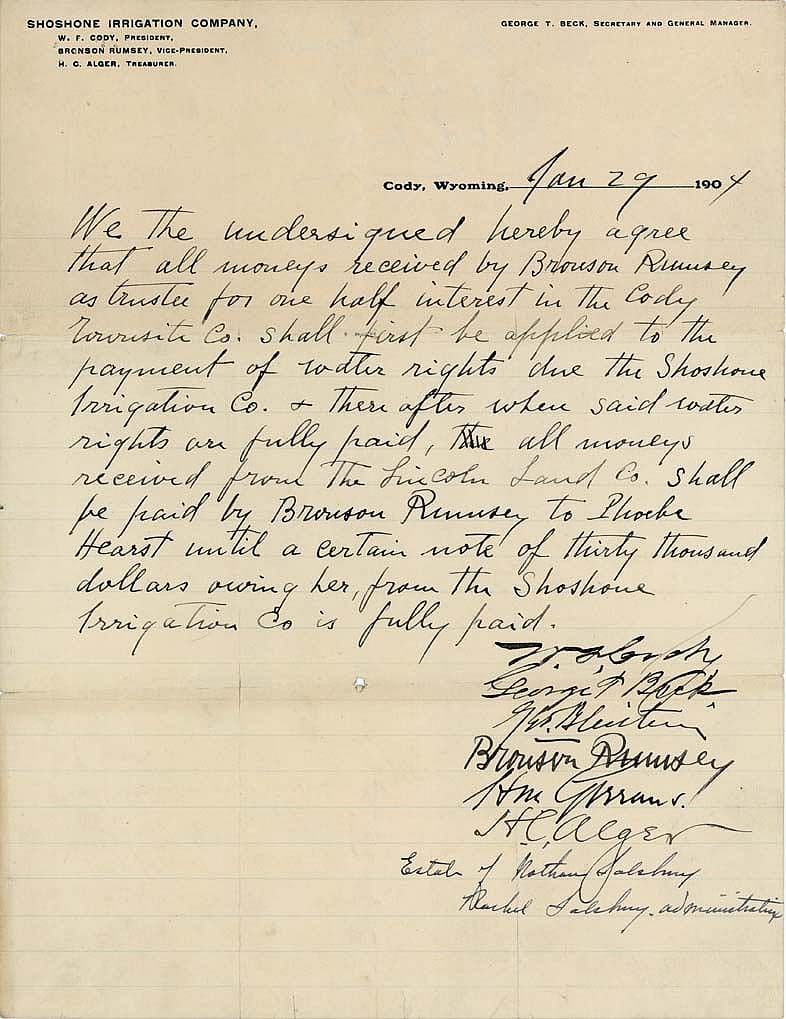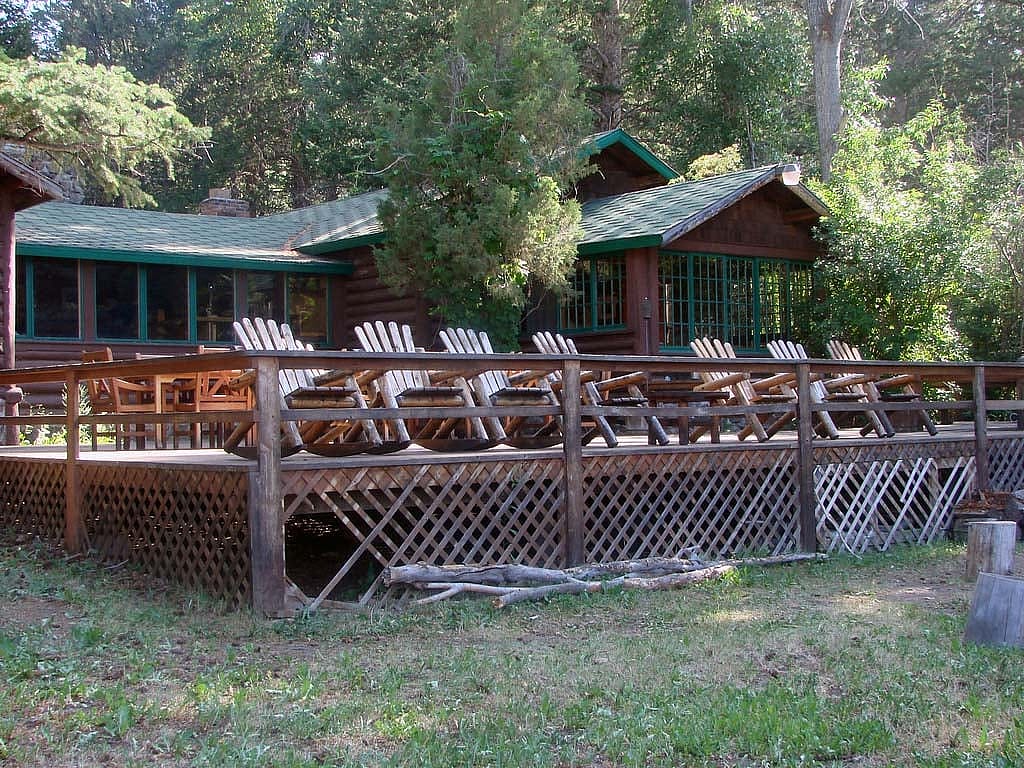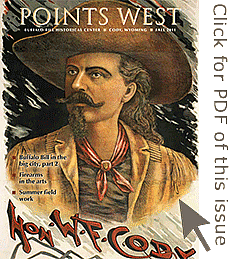
The Story of Bronson Rumsey and His Business Records – Points West Online
Originally published in Points West magazine
Fall 2011
From Buffalo, New York, to Cody, Wyoming: The Story of Bronson Rumsey and His Business Records
By Jeremy Johnston
On January 29, 1904, in Cody, Wyoming, members of the newly formed Cody Townsite Company—the same stakeholders as the Shoshone Irrigation Company—gathered to determine how best to spend revenue acquired from their recent dealings with the Lincoln Land Company, a partnering company of the Burlington Railroad. The railroad reached Cody in 1901, and an agreement between the members of the Shoshone Irrigation Company and the Lincoln Land Company for the sale of town lots in the developing community promised financial salvation for the troubled irrigation company. On the letterhead of the Shoshone Irrigation Company, the investors signed the following agreement:
We the undersigned hereby agree that all moneys received by Bronson Rumsey as trustee for one half interest in the Cody Townsite Co. shall first be applied to the payment of water rights due the Shoshone Irrigation Co. & there after where said water rights are fully paid,…all moneys received from the Lincoln Land Co. shall be paid by Bronson Rumsey to Phoebe Hearst until a certain note of thirty thousand dollars owing her from the Shoshone Irrigation Co. is fully paid.
Signed by W.F. Cody, George T. Beck, Geo. Bleistein,
Bronson Rumsey, H.M. Gerrans, H.C. Alger,
Estate of Nathan Salsbury-Rachael Salsbury, administrating

Those familiar with Cody, Wyoming, will no doubt recognize the names of the signees of this document as the “town-founders,” whose last names now grace the east/west streets crossing through town.

On August 16, 1904, Rumsey received a letter signed by a representative of Phoebe Hearst, mother of famous press mogul William Randolph Hearst, acknowledging the receipt of $30,238.88 that covered the amount due from the Shoshone Irrigation Company bond she held.
Bronson Rumsey, the individual entrusted by his fellow Cody partners to distribute the much-needed funds received from the Lincoln Land Company, carefully documented the business transactions stipulated by the signed agreement and filed away the receipts—including the one from Hearst—in his papers. A meticulous businessman, Rumsey also saved cancelled checks, receipts, correspondences, a town-plat map indicating sold lots, account statements from the Lincoln Land Company, inventories of the Cody Trading Company, and many other papers documenting the early history of Cody, Wyoming.

Rumsey later stored these interesting documents in a cashbox, and after his death in 1946, David Rumsey, currently of Buffalo, New York, acquired the cashbox with the business records. When the Papers of William F. Cody at the Buffalo Bill Center of the West learned more about these important documents, arrangements were made to purchase the collection with funds generously donated by Robert and Dine Dellenback through the Dellenback Family Foundation.
Today, Bronson Rumsey’s carefully documented financial dealings are archived in the McCracken Research Library of the Center, preserving an important facet of the history of William F. Cody and the development of Buffalo Bill’s town in the Big Horn Basin. They offer a rare and detailed glimpse into the routine business transactions of one of Buffalo Bill’s many business ventures.
The investors band together
Bronson Rumsey, a native of Buffalo, New York, first became interested in investing in Cody’s ventures in the Big Horn Basin when he accompanied fellow Buffalo resident George Bleistein on a hunt in the area with the famed Buffalo Bill in 1895. Bleistein was the president of the Buffalo Courier Printing Company, which printed a number of Buffalo Bill’s Wild West posters and programs. At the time of the hunt, William F. Cody—and his partners from Sheridan, Wyoming, George T. Beck and Horace Alger—in addition to Nate Salsbury, Cody’s partner in the Wild West and an acquaintance of Rumsey, were forming the Shoshone Irrigation Company.
The investors of this group hoped to divert water from the Shoshone River, then known as Stinking Water River. The company’s goal was to irrigate arid lands and develop a new community named in honor of William F. Cody—a venture that offered the potential of revenue from the sale of town lots. Rumsey invested $5,000 in the reclamation/town-building project with Bleistein and another Buffalo resident H. Montgomery Gerrans, who owned the posh Hotel Iroquois in Buffalo and was quite interested in Cody’s plan to build the future Irma Hotel.

Investing in various business ventures and real estate was not new to the Rumsey family. In 1664, the progenitor of the Rumsey family, Robert Rumsey Sr., arrived, probably from Wales, and purchased land in Fairfield, Connecticut. Around 1834, his descendant Aaron Rumsey (1797–1864) moved to Buffalo and established a leather tanning business. Born in 1823, Aaron’s son, Bronson Case Rumsey (father of future Cody partner and his namesake Bronson Rumsey), continued operating the family’s leather business in addition to investing in Buffalo real estate, various banks, and railroads.
Bronson Rumsey’s story
Bronson Rumsey, the future trustee of the Cody Townsite Company, was born in 1853 in Buffalo, New York. He attended Oxford University and continued to oversee his father’s business investments. Rumsey belonged to the Boone and Crockett Club, and he contributed an article on hunting mule deer in the Badlands of the Dakotas to their first published collection of articles titled American Big-Game Hunting, published in 1893. In addition to hunting in the West, Rumsey spent his spare time as a woodcarver and polo player; his obituary noted he played in America’s first polo match.

Rumsey’s first marriage to Mary Coxe resulted in three children, including Bronson “Bob” Case Rumsey, II, who later traveled to Cody and invested in the Blackwater Lodge west of Cody. (After losing the lodge due to his divorce settlement, Bob Rumsey then purchased the UXU Lodge, which, local legend has it, he originally nicknamed U – “#$%&*@” – U, an honor bestowed on his ex-wife, albeit a dubious one.)
Bob’s father, Bronson Rumsey, divorced Mary Coxe in 1897 and married Elizabeth Lockwood, the daughter of Daniel Newton Lockwood, a prominent attorney and Democrat who nominated Grover Cleveland for President of the United States. Bronson and Lockwood’s marriage produced four children including Daniel Lockwood Rumsey, the father of David Rumsey who later obtained his grandfather’s business records. Elizabeth died from complications of pneumonia in 1917. In his nineties, Bronson Rumsey married his nurse, Edna Lewis, and on August 18, 1946, Bronson Rumsey, the last living investor of the Cody town-founders, passed away at his summer home at Niagara-on-the-Lake, Ontario, Canada, at age 94.
Bronson Rumsey’s initial investment of $5,000 in the Shoshone Irrigation Company did not produce the giant profits he and his partners originally envisioned. Despite initial poor returns, Rumsey continued to invest in other business ventures in Wyoming including the mines in Sunlight Basin. The only success of his mining investments was to provide his son David with numerous stock certificates to wallpaper the bathroom of his summer home.
Although Rumsey’s investments in the region weren’t enormously lucrative, they did provide a legacy that honors him today. Residents of Cody travel down Rumsey Avenue, named in his honor; they snicker at his son Bob’s joke with the name UXU; and now they can learn more about the complicated financial dealings he oversaw by studying his collection of business records at the Center’s McCracken Research Library.
Sidebar: Bleistein’s hunting dog
Bronson Rumsey’s business records also provide some interesting tidbits of day-to-day transactions of the Cody Trading Company and lives of Cody residents. The Rumsey Collection contains the following telegrams regarding the purchase and shipment of an Airedale terrier by George Bleistein from local Cody resident, Mr. Mullendore:
April 23, 1913: George Bleistein wired J.M. Schwoob, manager of the Cody Trading Company, “See if you can get and express me a good airdale (sic) terrier between four and ten months old.”
April 25, 1913: Schwoob sent a telegraph reporting, “can get good airdale (sic) terrier two months old, parents registered, ten dollars. Those who know say it is a good one.”
April 25, 1913: Bleistein replied, “Express the pup to me here.”

Records indicate Bleistein paid the agreed $10 for the dog and an additional $3.65 to ship it to Buffalo, New York.
(Former Buffalo Bill Museum Assistant Curator Lynn Houze uncovered some additional information on Mr. Mullendore. It seems Horace Mullendore was a hunting/tourist guide from Nebraska. According to census records, he lived in Oklahoma, Kansas, and Montana before settling in Cody.)
“And this is speculation on my part,” Johnston concludes. “I believe Johnny Goff, my great-great-grandfather and Roosevelt’s hunting guide, brought the Airedale breed into the Cody region. Early newspapers praised his pack and his Airedale dogs. I’m thinking the Airedale sold to Bleistein by Mullendore may have been an offspring of one of Goff’s dogs.”
About the author
At the time this article was written, Jeremy Johnston was Managing Editor of The Papers of William F. Cody. In addition to continuing in that position, he is now the Center of the West’s Historian, and the Hal and Naoma Tate Endowed Chair of Western History. He previously served as Curator of the Center’s Buffalo Bill Museum.
Post 310
Written By
Nancy McClure
Nancy now does Grants & Foundations Relations for the Center of the West's Development Department, but was formerly the Content Producer for the Center's Public Relations Department, where her work included writing and updating website content, publicizing events, copy editing, working with images, and producing the e-newsletter Western Wire. Her current job is seeking and applying for funding from government grants and private foundations. In her spare time, Nancy enjoys photography, reading, flower gardening, and playing the flute.

















